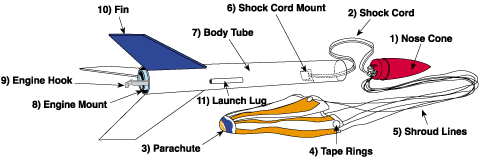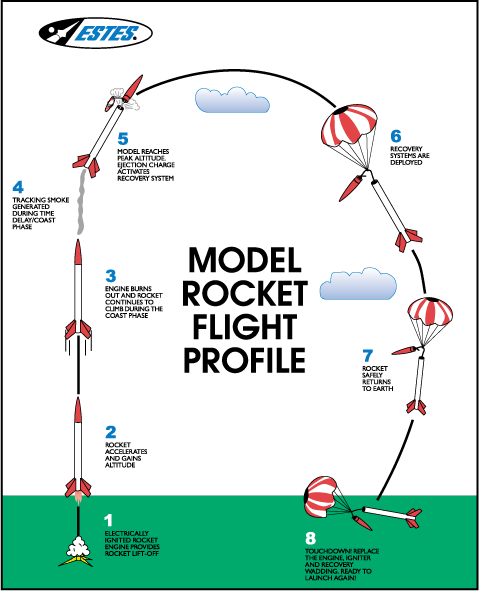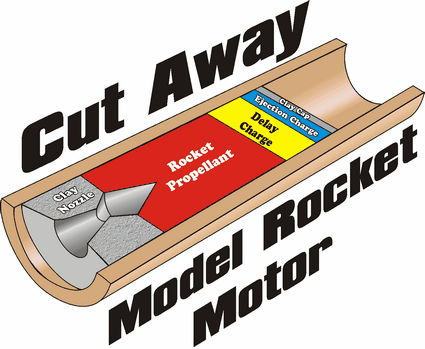Getting Started in Model Rocketry
- Posted on
- By Doug Pepperdine
- Posted in Family Hobbies, Kid's Hobbies, Model Rocketry

Reach for the sky with Model Rocketry. A fulfilling hobby that the whole family can enjoy. It's simple, inexpensive and worthwhile. Learn basic skills of model building and finish up with a working model that can go thousands of feet into the air!
Model Rockets are a very fulfilling way to spend family time. Most beginner rockets are extremely easy to build which means that you can be flying in hours. There are a few things a novice needs to know in order to properly appreciate this hobby and the purpose of this article is to explore the basics.
Safety is important in any hobby and because we're working with something that produces heat, it is especially important to pay attention to the proper procedures. More information can be found in the instructions that come with the rocket sets but here are some good tips in a nutshell:
*Choose a safe location to launch your rocket, away from tall grass, airports, buildings, large groups of people and animals
*Use the safety interlock (safety key) in your launch controller. The person hooking up the engine should have the key in their pocket.
*Maintain a safe distance from the rocket and keep all spectators away whenever the launch controller is enabled.
*Perform a countdown to ensure that everyone around knows that a rocket is about to launch.
*Do not try to ignite a model rocket engine using anything other than the ignitor that is designed for the engine.
The Anatomy of a model Rocket:

How a model rocket works:
 |
Model Rockets are a very simple device based on a propulsion system similar to a modern firework. They are also extremely safe when the directions are followed correctly. A rocket is launched using an electrical launching system which runs on batteries.
1) When the button is pushed on the launch controller, it sends power to an electrical ignitor inside the engine. This ignitor burns extremely hot and ignites the solid fuel which propels the rocket through it's flight.
2) Through the initial burn which is usually several seconds long, the rocket accelerates skyward.
3) After the initial burn, the rocket continues to climb through the coasting phase.
4) During this coasting phase, tracer smoke is generated so you can easily see your rocket in the sky.
5) When this delay is over, the engine's ejection charge generates back pressure to activate the recovery system, popping the nose cone off the rocket and deploying the parachute.
6,7) After the parachute is deployed, the rocket floats gently back to earth.
8) Ready for an additional flight after replacing the engine, Igniter and recovery wadding. |
The modeller and spectators all experience the rush of the rocket blasting off with extreme acceleration to impressive altitudes all at the push of a button. This rush of excitement can be enjoyed by people of any age so it's a great activity for families to enjoy together.
How to get started:
Model Rockets are broken down into several components and, in order to have a successful launch and recovery, all of these components need to be present.
*You need a rocket (There are many to choose from)
*You need a Launching Pad
*You need a Launch Controller (and batteries)
*You need your consumables (Engines, Igniters, recovery wadding)
*You need a great place to launch.
For the first three, (rocket, Launch pad and controller) it's usually best to purchase them all at the same time in a starter package because it's the least expensive option. The rocket that comes with a starter package is usually pretty basic, and easy to build, which is great when you're just starting out. You'll need some basic building materials and batteries to go with the starter package. Details for these items can be found on the outside of the box of the particular starter set you'd be looking at.
|
As far as consumables go, you'll need Engines, Igniters and recovery wadding. Engines - Engines are usually of the "black powder" type and you'll need one for every flight. Engines are categorized by their power rating and it is EXTREMELY IMPORTANT to stick with the recommended engines for your rocket. Every rocket lists which engines it can use and if you stray from the recommendation, you risk losing your rocket. Igniters - An Igniter is a small carbon and metal devices that is used to ignite the engine. During setup they are pushed deep into the nozzle of the engine, to make contact with the solid fuel. The Igniters are then electrically charged with the launch controller at launch time. Recovery Wadding - The wadding is fairly simple and is used as an insulation between the engine and the parachute (or streamer). If much heat is applied to the recovery system it may not deploy properly which would result in a crashed rocket. It is also very important that you don't use anything other than recover wadding as using other materials may present a fire hazard. |
 |
You need a great place to fly:
Always remember to put safety first and use common sense. Check your local bylaws. Choose an area that is clear of anything that could catch fire. Choose a field where there are no trees or obstacles for at least 50 meters in any direction. Stay well away from airports or any place where there is air traffic. Keep people and animals away from the launch site. Launch on a day where there is very little wind. (be sure to watch the clouds too. Sometimes it is very windy up high and you don't want to lose your rocket)
A note to educators:
Did you know that PM Hobbycraft offers discounts to School Teachers and other educators?
Model rocketry is an excellent way to teach may aspects of Science, Technology and Math for grades 3 to 12.
Lesson plans are available to help you guide your class
links:




